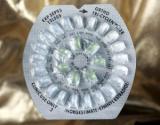A cyst is a fluid-filled sac. A cyst can develop almost anywhere on the body. Left untreated, they have been known, in very rare cases, to grow to as many as 200 pounds or more in some parts of the body.
Ovarian Cysts
An ovarian cyst is cyst that forms on or in the ovaries. They most commonly occur during a woman's childbearing years but can occur after that as well. There are several different types of ovarian cysts:
- -Follicle
- -Corpus luteum
- -Polycystic
- -Endometrioma
- -Cystadenoma
- -Dermoid
The most common type of ovarian cyst is known as a functional cyst, and the two types of functional cysts are the first two in the list above: follicle cysts and corpus luteum cysts.
Follicle Cysts
During a woman's menstrual cycle, the egg, within her ovary, grows within a little sac known as a follicle. When the egg matures, the sac opens and the egg is released. A follicle cyst occurs when the sac doesn't open and the egg isn't released. The cyst will grow but tends to disappear after one to three months.
Corpus Luteum Cysts
During menstruation, when the sac releases the egg, the sac itself dissolves in what's called corpus luteum—a hormone that prepares the body for the next egg. The key is the dissolving part, because sometimes the sac doesn't dissolve after releasing the egg. As a consequence, fluid builds up, allowing the cyst to grow up to three or four inches in size. Typically, they grow then go away in a few weeks. In that time, they can cause trouble with the ovary and cause pain.
Drugs taken for ovulation, such as Clomid, boost one's risk of developing these kinds of ovarian cysts.
Tests to Find Ovarian Cysts
Ovarian cysts can be found by a physician during a clinical exam. If a doctor suspects an ovarian cyst, a number of tests can be performed in order to determine type of cyst and the best treatment option. They include:
- -Ultrasound
- -Hormone level test
- -CA-125 blood test
- -Pregnancy test (to rule out this possibility)
Treating Cysts with Birth Control
While there are a handful of methods of treating ovarian cysts, including laparoscopy (a type of surgery), if a woman's body frequently forms functional cysts, it is common for doctors to prescribe the birth control pill. The reason? To prevent the patient from ovulating. No ovulation means a much lower possibility of developing functional cysts, since they are directly related to ovulation. A similar option is the hormonal contraceptive injection Depo-Provera.
Ultimately, a woman can't do anything on her own to prevent the development of ovarian cysts. However, in most instances they neither are symptomatic nor a health risk, and they tend to disappear on their own. In the event the symptoms associated with ovarian cysts persist, one should contact one's doctor or health care professional. The US Department of Health and Human Services offers a list of symptoms associated with ovarian cysts.


